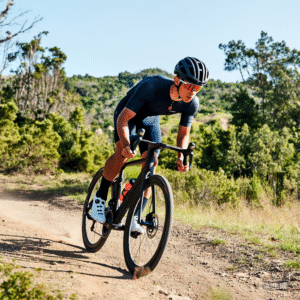In the competitive landscape of mountain bike (MTB) manufacturing, carbon fiber frames have become the gold standard for balancing lightweight design, durability, and ride quality. Among the critical factors determining frame performance are the grades of carbon fiber used, particularly T700 and T1000. This article explores how leading carbon MTB frame factories leverage these materials to optimize performance, while maintaining cost-efficiency and structural integrity.
Understanding Carbon Fiber Grades: T700 vs. T1000
Carbon fiber is categorized by its tensile strength and modulus of elasticity, which dictate its stiffness and resistance to deformation. T700 and T1000 are two of the most widely used grades in high-end bike frame production:
-
T700: With a tensile strength of 4,900 MPa and a modulus of 230 GPa, T700 offers a balanced blend of strength, flexibility, and affordability. It is often employed in areas requiring impact resistance, such as the bottom bracket and chainstays. -
T1000: Boasting a tensile strength of 5,500 MPa and a modulus of 300 GPa, T1000 is stiffer and lighter, making it ideal for high-stress zones like the head tube and down tube where rigidity is critical for precise handling.
Top factories strategically integrate these materials to create frames that excel in specific riding conditions. For instance, T1000’s stiffness enhances power transfer during climbs, while T700’s韧性 (toughness) absorbs shocks on technical descents.
The Role of Layup Techniques in Performance Optimization
Material selection alone does not define frame quality. Expert manufacturers employ advanced layup techniques to maximize the potential of T700 and T1000. This involves:
-
Fiber Orientation: Carbon plies are layered at 0°, 45°, 90°, and ±30° angles to distribute stress evenly. For example, 45° layers improve torsional stiffness in the bottom bracket, while 90° layers resist lateral flex. -
Resin Systems: High-temperature epoxy resins bind the fibers, ensuring durability under extreme conditions. Premium factories use aerospace-grade resins to minimize weight while maintaining bond strength. -
Molding Processes: Monocoque construction, where the frame is molded as a single piece, reduces the need for bonding agents and joints, which can create weak points. This method is labor-intensive but yields superior structural integrity.
By combining T700’s durability with T1000’s rigidity through precise layup strategies, factories can tailor frames to meet diverse rider demands, from enduro racing to trail riding.
Impact on Ride Quality and Weight
The interplay between T700 and T1000 directly influences two key metrics: weight and ride dynamics.
-
Weight Reduction: T1000’s higher strength-to-weight ratio allows factories to reduce material volume without compromising durability. A full carbon MTB frame using T1000 in high-load zones can weigh as little as 850 grams, compared to 1,000–1,200 grams for T700-dominant designs. -
Stiffness vs. Comfort: Overuse of T1000 can result in a harsh ride, as its brittleness absorbs less vibration. Leading factories mitigate this by blending T700 into seat stays and top tubes, where damping is crucial for rider comfort. This hybrid approach ensures frames remain responsive yet forgiving on rough terrain.
For example, a factory producing frames for cross-country (XC) riders might prioritize T1000 in the front triangle for pedaling efficiency, while incorporating T700 in the rear triangle to enhance compliance.
Cost Considerations and Production Challenges
T1000’s premium pricing poses a challenge for manufacturers aiming to balance performance with affordability. To address this, top factories adopt a strategic material allocation model:
-
Zonal Reinforcement: High-cost T1000 is reserved for critical stress zones, while T700 covers less demanding areas. This reduces material costs by up to 30% without sacrificing overall performance. -
Scalable Designs: Modular frame architectures allow factories to reuse molds and layup templates across product lines, spreading R&D costs over larger production volumes.
Despite these efficiencies, T1000’s fragility during manufacturing requires specialized equipment and expertise. For instance, improper heat distribution during curing can cause microfractures, necessitating rigorous quality control protocols.
Testing and Validation: Ensuring Industry-Leading Standards
Reputable factories adhere to international standards such as ISO 4210 and EN 14781 to validate frame safety and performance. Testing protocols include:
-
Fatigue Testing: Frames undergo 100,000+ pedal stroke simulations to assess long-term durability. -
Impact Resistance: Drop tests simulate crash scenarios, ensuring frames meet or exceed 12 N·m penetration resistance requirements. -
Stiffness Measurements: Advanced load cells quantify lateral and torsional stiffness, ensuring alignment with design targets.
Factories utilizing T1000 often achieve stiffness-to-weight ratios exceeding 25 N·m/kg, a benchmark for high-performance MTB frames.
Conclusion
The choice between T700 and T1000 is not a binary one; it is a nuanced engineering decision that defines a frame’s character. Leading carbon MTB frame factories excel by harmonizing these materials to meet the demands of modern riders. Through precision layup techniques, zonal reinforcement, and rigorous testing, they deliver products that marry lightweight agility with uncompromising strength. As material science evolves, the integration of next-generation fibers like T1100 and M40X will further push the boundaries of performance—but for now, T700 and T1000 remain the backbone of elite MTB frame manufacturing.
References
-
Composites Manufacturing Association. (2022). Advanced Carbon Fiber Applications in Cycling. -
International Journal of Sports Engineering. (2021). “”Material Selection and Frame Dynamics in Mountain Bikes.”” -
Global Cycling Industry Report. (2023). Trends in High-Performance Bicycle Production.”
